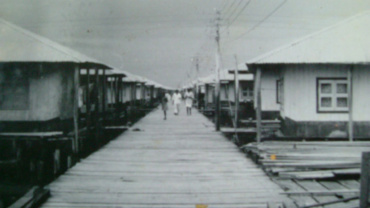In the Happy City of Ayetoro, the water was not an obstacle but a way of life. Homes were built on stilts, rising gracefully above the tide, with reflections shimmering in the lagoon below. But what gave these houses their true sense of belonging were the wooden walkways — narrow planks stretching between clusters of family homes, forming pathways that stitched the community together.
For the first settlers in 1947, building above water was essential. The swampy terrain left little solid ground for conventional streets. Yet the founders were determined to live closely, to nurture the bonds of kinship and faith that defined their communal vision. The solution was simple, practical, and ingenious: wooden walkways that carried people from one doorway to another, transforming a collection of houses into living neighbourhoods.
Archival photographs capture children skipping across these planks, mothers balancing baskets on their heads, and elders pausing to chat as they leaned on railings worn smooth by countless footsteps. Oral histories describe how, in the evenings, families would linger on the walkways to share news, sing hymns, or watch the glow of lanterns reflected in the water. The walkways were not merely bridges; they were social spaces where everyday life unfolded.
The act of building the walkways was itself communal. When a new family home was raised, neighbours joined hands to extend the planks so that the household was not left isolated. Men hammered timber into place, women sang as they prepared food for the workers, and children carried nails and rope. In this way, each walkway became more than wood and nails — it was a declaration of belonging. No one stood apart; every home was bound to the others.
The design of the walkways reflected both necessity and imagination. Some were short and direct, while others zigzagged across the water, linking multiple households in intricate patterns. At dawn, fishermen carried their nets along these paths toward the shore. At dusk, schoolchildren hurried across them, eager to get home before evening prayers. Even weddings and ceremonies spilled onto the walkways, as processions of singers and drummers crossed from one family cluster to another, uniting the community in celebration.

Visitors to Ayetoro in the 1950s and 1960s marvelled at the network of wooden paths. To them, it seemed like a floating city, where streets were not paved with stone but balanced lightly above the water. To residents, it was simply home. The walkways symbolised Ayetoro’s resilience and creativity, proof that the community could adapt the environment to its needs without losing its closeness.
Today, many of those walkways have been claimed by the sea. Yet in memory, they remain vivid: the sound of footsteps on timber, the laughter of children racing along the planks, the quiet conversations between neighbours leaning on the rails. As one elder put it, “The walkways were our lifelines. They reminded us that in Ayetoro, no home stood alone.”




